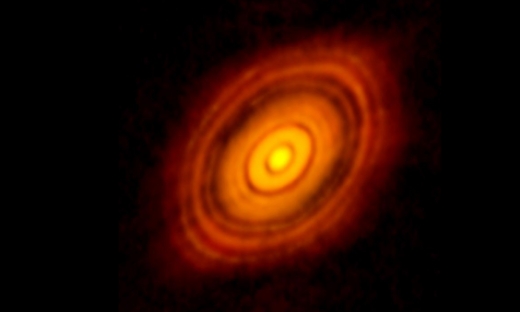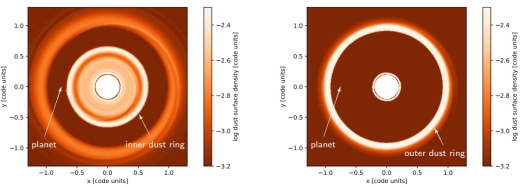Earlier in the week I talked about Astronomy Rewind, an ambitious citizen science project dedicated to recovering old astronomical imagery and digitizing it for comparison with new data. Now I’ve learned that another citizen science effort, Planet Finders, is working with simulated data from the Transiting Exoplanet Survey Satellite (TESS), planning to transition into real TESS data as soon as they become available. Have a look at this effort here if you are interested in becoming a beta tester. TESS will be a hugely significant exoplanet mission particularly in terms of nearby stars, so becoming a part of this project should be an exciting venture indeed.
On with today’s post, which I would have actually run yesterday if I had read the paper soon enough, as it offers insights into Wednesday’s entry on protoplanetary disks. As we’ve seen, these can become the discovery grounds for young planets. In the case of the 2-million year old CI Tau, that meant an already confirmed gas giant in a ‘hot Jupiter’ configuration, along with three other gas giants, two of them far from the central star. Hence the question: Where did the hot Jupiter CI Tau b form? Because if it migrated, it did so early in the history of this system.

Now we have a separate research effort attempting to show that planet migration within a protoplanetary disk can be identified through markers within the disk itself. The idea is to produce an observational marker that can guide future research and tell us whether, within a given system, a planet is moving inward through the disk or staying within its existing orbit.
Image: Astrophysicist Farzana Meru: Credit: University of Warwick.
Lead author Farzana Meru (University of Warwick, UK), working with colleagues at Cambridge University, describes an observational signature in young stellar system dust rings. As with the CI Tau work, the new study involves the Atacama Large Millimeter/submillimeter Array (ALMA), which is able to probe such disks in intricate detail, revealing structure in the form of clumps, gaps, spiral arms, crescents and rings. Even more to the point, by working at different millimeter frequencies, ALMA can identify clustering material in different particle sizes.

Image: Example of a protoplanetary disk. This is an ALMA image of the young star HL Tau and its disk. The image reveals multiple rings and gaps that herald the presence of emerging planets as they sweep their orbits clear of dust and gas. The image was released Nov. 6, 2014. ALMA (NRAO/ESO/NAOJ); C. Brogan, B. Saxton (NRAO/AUI/NSF).
The question, then, is what can variations in dust particle size tell us? The researchers perform simulations of movement within a ring of gas and dust in the presence of migrating planets of relatively low mass, from 12 to 60 Earth masses. The results show that the gas pressure profile of the disk varies significantly depending on whether the planet is migrating or stationary.
From the paper:
…the pressure perturbation exterior to the planet is weaker while that interior to the planet becomes more important for migrating planets. Dust can therefore be enhanced both interior or exterior to the planet and the result is governed by the relative values of the planet and dust velocities. For small sizes, the dust velocity in the outer disc is too small to keep up with the moving pressure maximum while in the inner disc it moves faster and can collect, forming a dust density enhancement interior to the planet.
For larger dust particles, the dust velocity in the disk exterior to the planet’s orbit is high enough to keep up with the pressure perturbation, producing what the authors describe as a ‘dust density enhancement’ in this region. We would thus expect smaller particles in the interior ring, larger particles in the exterior. By studying the inner and outer rings around the planetary orbit at different wavelengths, we should be able to show whether or not the planet is migrating.
We’re talking about small differences indeed — a migrating planet at 30 AU that is 30 times the mass of the Earth should, according to this modeling, be associated with an inner ring consisting of particles less than a millimeter in size, while those in the outer ring would measure slightly over a millimeter. But this is a workable observable, for as ALMA increases the wavelengths at which it observes, the inner dust ring fades while the exterior ring becomes brighter. This is because the emissivity of dust grains depends on the maximum grain size in the mixture.

Image: This is the paper’s Figure 7. Caption: “Dust density rendered simulation image of the disc with a 30M? migrating planet at Rp = 0.75 for dust with Stokes numbers of 0.02 (left) and 0.2 (right). The small dust forms a ring interior to the planet while the large dust forms a ring exterior to it.” The ‘Stokes number’ refers to the movement of particles in flow. What is significant here is the separation of small- and large-particle dust accumulations. Credit: Meru et al.
The movement of the dust is the key. In the inner ring, we are seeing smaller particles because these move inwards more slowly than the planet itself, accumulating in the inner ring, while large dust particles are found in the exterior ring because they move at higher velocity than the smaller particles and keep pace with the planet in its movement inward. Over time, the composition of the two rings is distinctive enough to become an ALMA observable.
We’re entering an era when protoplanetary disks are becoming the subject of intense scrutiny thanks to facilities like ALMA, along with the Spectro- Polarimetric High-contrast Exoplanet REsearch (SPHERE) instrument on the Very Large Telescope (VLT) and the Gemini Planet Instrument (GPI) on the Gemini Telescope. And we’re learning that most such disks show sub-structure susceptible to such analysis. We need observational benchmarks like these because a hot Jupiter like CI Tau’s can be the result of migration, but it could also achieve its tight orbit because of gravitational interactions early in the development of the system.
Applying observational constraints to planetary migration could become a potent tool in untangling a young system’s evolution. The work is promising but still in its early stages. In principle, write the researchers, “…it may be possible to use the location of dust rings in order to detect planetary migration, although the feasibility of this measurement is yet to be established.”
The paper is Meru et al., “Is the ring inside or outside the planet?: The effect of planet migration on dust rings,” accepted at Monthly Notices of the Royal Astronomical Society (preprint).



There must be a way to use a computer simulation with a 30 Earth mass body and it’s collision with dust particles with a mathematical formula to make a prediction. My intuition tells if there is some migration, it can’t be much since the larger dust is only slightly heavier than the lighter dust which cancel out the movement of the gas giant or there is very little movement.
Also what if there is not any or very little movement and no migration? Would it completely invalidate the idea that gas giants had to start with rocky cores?
Fantastic report, though disks are easier to observe I am still impressed they’ve been able to get such good data. It provide not only an explanation for hot Jupiters, perhaps also a model for what happened in the past in our own solar system. Some think Jupiter started to move in that way. But for some reason changed it’s mind. This research might have more than one use, also for the search for a second Earth. I am in doubt, but some think a Terrestrial planet could survive such migration.
Have been doing a little more research on the Lagrange points and their instabilities plus the interplanetary superhighway in relation to the protoplanetary disk. See image:
https://i.stack.imgur.com/JO0UJ.jpg
1.In relation to Jupiter L4 and L5:
For some mysterious reason there are more big asteroids at L4 than L5, why are there more asteroids at L4?
Very good article on the points:
http://math.ucr.edu/home/baez/lagrange.html
https://minorplanetcenter.net//iau/Animations/Middle.gif
https://www.exploremars.org/wp-content/uploads/2013/06/Petr-Sheirich-2005-our-solar-system-in-motion.gif
2. Development of a planet at the L2 point behind Jupiter.
This could prove to cause some very unexpected results because the planet being permanently in the magnetosphereic tail of Jupiter. How this would effect it’s forming and possible magnetic properties and could organics be captured from Jupiter to enrich the planets carbon and habitability.
https://upload.wikimedia.org/wikipedia/commons/f/fa/Currents_in_Jovian_Magnetosphere.png
3. How binary asteroids, comets and planets such as Uranus/Neptune and Earth/Venus could of formed:
The evolution of triples with a Roche-lobe filling outer star.
http://inspirehep.net/record/1253054/plots
See image:
http://inspirehep.net/record/1253054/files/fig_fig_lagrange_contour.png
One other factor that may have large effects on planetary development are vorticities that develop around objects as they form, like the whirlpool that forms in a stream when the water passes a rock.
Sounds like a good project for Deep Learning AI
Back in the early days of doppler detection of jovian size planets, had the good fortune to attend a conference (Stoney Brook, NY) where the migration problem was discussed. A frequently used term was “density wave”, which had an analogous application in arms of spiral galaxies.
I had trouble understanding the mechanism, admittedly, but some concepts came a little easier, e.g., the idea of momentum exchange between a small body such as a space probe and a large planet such as Jupiter. Say if a terrestrial space probe coming out to Jupiter were approaching it from behind in heliocentric coordinates, in jovian coordinates it would pass in a hyperbolic path that would fling it out ahead of Jupiter with extra heliocentric velocity. From this exchange, Jupiter would lose an infinitesimal amount of momentum or velocity. However, if Jupiter came up from behind on a space probe, the spacecraft would lose velocity and fall back, but Jupiter would be sped up.
Now let’s say this process were to go on with a dust disc zillions and zillions of times. Particles in Jupiter’s orbit would be disturbed, of course, but why should the bias fall one way or another? Why would
Jupiter’s momentum (or a body like it in an early stage of star system formation) bias toward one momentum exchange type or another?
Well, I can think of a couple of clues.
If you have a large disc with a high density it is not necessarily uniform in composition, especially with radial distance and
local equilibrium temperatures affecting the ice composition.
A number of mechanisms do cause differentiation.
Prior to that 1990s conference, I had the opportunity to work on some cosmic dust studies in which the Poynting Robertson effect was a consideration. The study was more concerned with examples such as zodiacal dust cases in the solar system, and individual resonances related to solar system planets, but the overall behavior was influenced by dust particles of low radii experiencing decay toward the sun, a relativistic asymmetry in the momentum imparted by solar photons on small bodies, causing the dust particles to spiral inward. Really small particles though would be blasted out by photon radiation pressure, but dust particles of a certain larger radius range would spiral inward.
Maybe disc structure and jovian mass position can precipitate a migration in one direction or another, but if Poynting Robertson effects are causing low radius particles to decay inward, there might be some sort of bias in the surrounding hyperbolic flow. But to brake the jovian world, more mass would have to be drawn in from behind and hurled forward than pulled back from ahead and thrown backward.
Depending on collision distance and other issues, there might be larger considerations than Poynting Robertson, but there might be a window
when it works its magic as well, and a cohort of particles migrating inward could create a bias on which way a planet migrates.
The Poynting Robertson effect and Yarkovsky effect only effect dust and small bodies. I don’t think they can add enough or subtract enough angular momentum to gas giant sized protoplanets to cause very much migration. One needs large bodies and Lagrangian points etc which is why I am sticking to the idea that the gas giants in CI Tau formed in situ and won’t migrate. I predict they won’t migrate much. I like the idea that gas giants don’t have to have solid rocky cores and none of them may have them. The only way to prove it would be to telescopically observe many different protoplantary infant systems with the same class star or different stars and get their spectra. One could also observe the same system from it’s birth over many years from a few hundred thousand to several million but that would take a long time.
Evolution of protoplanetary disks from their taxonomy in scattered
light: spirals, rings, cavities, and shadows.
October 22, 2018
ABSTRACT
Context. Dozens of protoplanetary disks have been imaged in scattered light during the last decade.
Aims. The variety of brightness, extension, and morphology from this census motivates a taxonomical study of protoplanetary disks
in polarimetric light to constrain their evolution and establish the current framework of this type of observation.
Methods. We classified 58 disks with available polarimetric observations into six major categories (Ring, Spiral, Giant, Rim, Faint,
and Small disks) based on their appearance in scattered light. We re-calculated the stellar and disk properties from the newly available
GAIA DR2 and related these properties with the disk categories.
Results. More than half of our sample shows disk substructures. For the remaining sources, the absence of detected features is due to
their faintness, their small size, or the disk geometry. Faint disks are typically found around young stars and typically host no cavity.
There is a possible dichotomy in the near-infrared (NIR) excess of sources with spiral-disks (high) and ring-disks (low). Like spirals,
shadows are associated with a high NIR excess. If we account for the pre-main sequence evolutionary timescale of stars with different
mass, spiral arms are likely associated to old disks. We also found a loose, shallow declining trend for the disk dust mass with time.
Conclusions. Protoplanetary disks may form substructures like rings very early in their evolution but their detectability in scattered
light is limited to relatively old sources (&5 Myr) where the recurrently detected disk cavities cause the outer disk to be illuminate.
The shallow decrease of disk mass with time might be due to a selection effect, where disks observed thus far in scattered light are
typically massive, bright transition disks with longer lifetimes than most disks. Our study points toward spirals and shadows being
generated by planets of a fraction of a jupiter mass to a few jupiter masses in size that leave their (observed) imprint on both the inner
disk near the star and the outer disk cavity.
https://arxiv.org/pdf/1810.04564.pdf
2019 is now “officially” designated(by me) the Alpha Centauri system year! I have posted comments previously about a PLANNED campaign to image planets around Alpha Centauri A and Alpha Centauri B, and a not yet planned attempt to image Proxima B perhaps even before the planned campaign mentioned above. Now, for the piece de resistance! Tess will observe Alpha Centauri B from April 22 to June 19, 2019 and will be able to FINALLY confirm or refute the putative planet(NOT the 3 day one)from which a 5 sigma transit-like signal was obtained by HST a few years ago!
Some planetary systems just aren’t into heavy metal.
October 24, 2018, Yale University
https://phys.org/news/2018-10-planetary-heavy-metal.html
Compact multi-planet systems are more common around metal poor hosts.
John M. Brewer, Songhu Wang, Debra A. Fischer, Daniel Foreman-Mackey
(Submitted on 23 Oct 2018)
“In systems with detected planets, hot-Jupiters and compact systems of multiple planets are nearly mutually exclusive. We compare the relative occurrence of these two architectures as a fraction of detected planetary systems to determine the role that metallicity plays in planet formation. We show that compact multi-planet systems occur more frequently around stars of increasingly lower metallicities using spectroscopically derived abundances for more than 700 planet hosts. At higher metallicities, compact multi-planet systems comprise a nearly constant fraction of the planet hosts despite the steep rise in the fraction of hosts containing hot and cool-Jupiters. Since metal poor stars have been underrepresented in planet searches, this implies that the occurrence rate of compact multis is higher than previously reported. Due to observational limits, radial velocity planet searches have focused mainly on high-metallicity stars where they have a higher chance of finding giant planets. New extreme-precision radial velocity instruments coming online that can detect these compact multi-planet systems can target lower metallicity stars to find them.”
Maybe this is where we should be looking for intelligent life, since these stable planetary system may not take 3.8 billion years to oxygenate and have animals develop. These systems will have a lot of organic compounds because of the higher ratio of ?-element to iron…
https://arxiv.org/abs/1806.08368
Correct link for:
Astrophysics > Earth and Planetary Astrophysics.
Compact multi-planet systems are more common around metal poor hosts.
https://arxiv.org/abs/1810.10009
Reminds me of the articles from around 2011-2015 (“Heavy metal stars produce Earth-Like planets” & “Revealing A Universal Planet-Metallicity Correlation For Planets”) etc. They were later modified/replaced by papers which reflected the discoveries around the stars with lower metallicities. But overall, from my understanding, each of those theories/observations is still complicated by the matter of detection bias(es) and remaining uncertainty. There’s a paucity of Jupiter analogs, not to mention complete lack of terrestrial analogs in long period orbits.
“TESS will be a hugely significant exoplanet mission particularly in terms of nearby stars (…)”
Well, I don’t share this optimism, since it’s apparently best suited for observing red dwarfs. Personally, I’d count on PLATO or improved radial velocity detection methods.